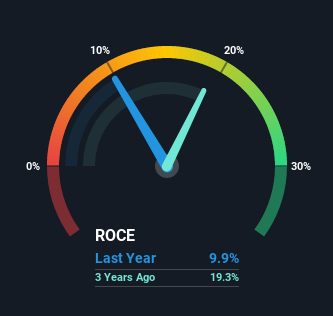- Greece
- /
- Oil and Gas
- /
- ATSE:ELIN
Elinoil Hellenic Petroleum (ATH:ELIN) Will Be Hoping To Turn Its Returns On Capital Around

What trends should we look for it we want to identify stocks that can multiply in value over the long term? Firstly, we'll want to see a proven return on capital employed (ROCE) that is increasing, and secondly, an expanding base of capital employed. This shows us that it's a compounding machine, able to continually reinvest its earnings back into the business and generate higher returns. Having said that, from a first glance at Elinoil Hellenic Petroleum (ATH:ELIN) we aren't jumping out of our chairs at how returns are trending, but let's have a deeper look.
What is Return On Capital Employed (ROCE)?
For those that aren't sure what ROCE is, it measures the amount of pre-tax profits a company can generate from the capital employed in its business. Analysts use this formula to calculate it for Elinoil Hellenic Petroleum:
Return on Capital Employed = Earnings Before Interest and Tax (EBIT) ÷ (Total Assets - Current Liabilities)
0.099 = €7.9m ÷ (€239m - €159m) (Based on the trailing twelve months to June 2021).
So, Elinoil Hellenic Petroleum has an ROCE of 9.9%. On its own, that's a low figure but it's around the 8.3% average generated by the Oil and Gas industry.
See our latest analysis for Elinoil Hellenic Petroleum

While the past is not representative of the future, it can be helpful to know how a company has performed historically, which is why we have this chart above. If you'd like to look at how Elinoil Hellenic Petroleum has performed in the past in other metrics, you can view this free graph of past earnings, revenue and cash flow.
What Does the ROCE Trend For Elinoil Hellenic Petroleum Tell Us?
When we looked at the ROCE trend at Elinoil Hellenic Petroleum, we didn't gain much confidence. Over the last five years, returns on capital have decreased to 9.9% from 15% five years ago. And considering revenue has dropped while employing more capital, we'd be cautious. This could mean that the business is losing its competitive advantage or market share, because while more money is being put into ventures, it's actually producing a lower return - "less bang for their buck" per se.
On a side note, Elinoil Hellenic Petroleum's current liabilities are still rather high at 66% of total assets. This effectively means that suppliers (or short-term creditors) are funding a large portion of the business, so just be aware that this can introduce some elements of risk. Ideally we'd like to see this reduce as that would mean fewer obligations bearing risks.
What We Can Learn From Elinoil Hellenic Petroleum's ROCE
From the above analysis, we find it rather worrisome that returns on capital and sales for Elinoil Hellenic Petroleum have fallen, meanwhile the business is employing more capital than it was five years ago. Since the stock has skyrocketed 131% over the last five years, it looks like investors have high expectations of the stock. Regardless, we don't feel too comfortable with the fundamentals so we'd be steering clear of this stock for now.
On a final note, we found 4 warning signs for Elinoil Hellenic Petroleum (3 don't sit too well with us) you should be aware of.
If you want to search for solid companies with great earnings, check out this free list of companies with good balance sheets and impressive returns on equity.
If you're looking to trade Elinoil Hellenic Petroleum, open an account with the lowest-cost platform trusted by professionals, Interactive Brokers.
With clients in over 200 countries and territories, and access to 160 markets, IBKR lets you trade stocks, options, futures, forex, bonds and funds from a single integrated account.
Enjoy no hidden fees, no account minimums, and FX conversion rates as low as 0.03%, far better than what most brokers offer.
Sponsored ContentValuation is complex, but we're here to simplify it.
Discover if Elinoil Hellenic Petroleum might be undervalued or overvalued with our detailed analysis, featuring fair value estimates, potential risks, dividends, insider trades, and its financial condition.
Access Free AnalysisHave feedback on this article? Concerned about the content? Get in touch with us directly. Alternatively, email editorial-team (at) simplywallst.com.
This article by Simply Wall St is general in nature. We provide commentary based on historical data and analyst forecasts only using an unbiased methodology and our articles are not intended to be financial advice. It does not constitute a recommendation to buy or sell any stock, and does not take account of your objectives, or your financial situation. We aim to bring you long-term focused analysis driven by fundamental data. Note that our analysis may not factor in the latest price-sensitive company announcements or qualitative material. Simply Wall St has no position in any stocks mentioned.
About ATSE:ELIN
Elinoil Hellenic Petroleum
Engages in the supply of liquid and solid fuels, and lubricants for industrial plants worldwide.
Moderate with mediocre balance sheet.
Market Insights
Community Narratives



